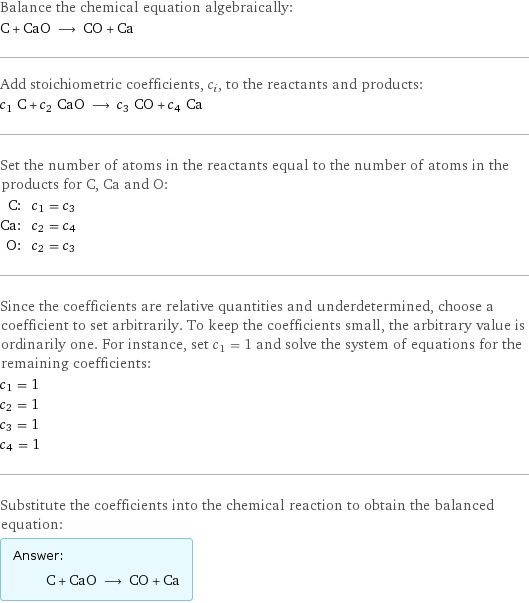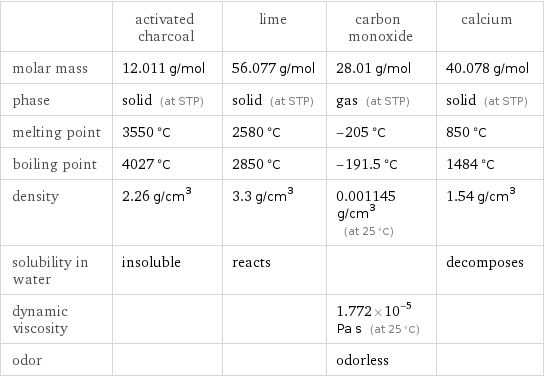Input interpretation

C activated charcoal + CaO lime ⟶ CO carbon monoxide + Ca calcium
Balanced equation

Balance the chemical equation algebraically: C + CaO ⟶ CO + Ca Add stoichiometric coefficients, c_i, to the reactants and products: c_1 C + c_2 CaO ⟶ c_3 CO + c_4 Ca Set the number of atoms in the reactants equal to the number of atoms in the products for C, Ca and O: C: | c_1 = c_3 Ca: | c_2 = c_4 O: | c_2 = c_3 Since the coefficients are relative quantities and underdetermined, choose a coefficient to set arbitrarily. To keep the coefficients small, the arbitrary value is ordinarily one. For instance, set c_1 = 1 and solve the system of equations for the remaining coefficients: c_1 = 1 c_2 = 1 c_3 = 1 c_4 = 1 Substitute the coefficients into the chemical reaction to obtain the balanced equation: Answer: | | C + CaO ⟶ CO + Ca
Structures

+ ⟶ +
Names

activated charcoal + lime ⟶ carbon monoxide + calcium
Equilibrium constant
![Construct the equilibrium constant, K, expression for: C + CaO ⟶ CO + Ca Plan: • Balance the chemical equation. • Determine the stoichiometric numbers. • Assemble the activity expression for each chemical species. • Use the activity expressions to build the equilibrium constant expression. Write the balanced chemical equation: C + CaO ⟶ CO + Ca Assign stoichiometric numbers, ν_i, using the stoichiometric coefficients, c_i, from the balanced chemical equation in the following manner: ν_i = -c_i for reactants and ν_i = c_i for products: chemical species | c_i | ν_i C | 1 | -1 CaO | 1 | -1 CO | 1 | 1 Ca | 1 | 1 Assemble the activity expressions accounting for the state of matter and ν_i: chemical species | c_i | ν_i | activity expression C | 1 | -1 | ([C])^(-1) CaO | 1 | -1 | ([CaO])^(-1) CO | 1 | 1 | [CO] Ca | 1 | 1 | [Ca] The equilibrium constant symbol in the concentration basis is: K_c Mulitply the activity expressions to arrive at the K_c expression: Answer: | | K_c = ([C])^(-1) ([CaO])^(-1) [CO] [Ca] = ([CO] [Ca])/([C] [CaO])](../image_source/9724f47c3bd8a6ad0dacfcb25d0e4aea.png)
Construct the equilibrium constant, K, expression for: C + CaO ⟶ CO + Ca Plan: • Balance the chemical equation. • Determine the stoichiometric numbers. • Assemble the activity expression for each chemical species. • Use the activity expressions to build the equilibrium constant expression. Write the balanced chemical equation: C + CaO ⟶ CO + Ca Assign stoichiometric numbers, ν_i, using the stoichiometric coefficients, c_i, from the balanced chemical equation in the following manner: ν_i = -c_i for reactants and ν_i = c_i for products: chemical species | c_i | ν_i C | 1 | -1 CaO | 1 | -1 CO | 1 | 1 Ca | 1 | 1 Assemble the activity expressions accounting for the state of matter and ν_i: chemical species | c_i | ν_i | activity expression C | 1 | -1 | ([C])^(-1) CaO | 1 | -1 | ([CaO])^(-1) CO | 1 | 1 | [CO] Ca | 1 | 1 | [Ca] The equilibrium constant symbol in the concentration basis is: K_c Mulitply the activity expressions to arrive at the K_c expression: Answer: | | K_c = ([C])^(-1) ([CaO])^(-1) [CO] [Ca] = ([CO] [Ca])/([C] [CaO])
Rate of reaction
![Construct the rate of reaction expression for: C + CaO ⟶ CO + Ca Plan: • Balance the chemical equation. • Determine the stoichiometric numbers. • Assemble the rate term for each chemical species. • Write the rate of reaction expression. Write the balanced chemical equation: C + CaO ⟶ CO + Ca Assign stoichiometric numbers, ν_i, using the stoichiometric coefficients, c_i, from the balanced chemical equation in the following manner: ν_i = -c_i for reactants and ν_i = c_i for products: chemical species | c_i | ν_i C | 1 | -1 CaO | 1 | -1 CO | 1 | 1 Ca | 1 | 1 The rate term for each chemical species, B_i, is 1/ν_i(Δ[B_i])/(Δt) where [B_i] is the amount concentration and t is time: chemical species | c_i | ν_i | rate term C | 1 | -1 | -(Δ[C])/(Δt) CaO | 1 | -1 | -(Δ[CaO])/(Δt) CO | 1 | 1 | (Δ[CO])/(Δt) Ca | 1 | 1 | (Δ[Ca])/(Δt) (for infinitesimal rate of change, replace Δ with d) Set the rate terms equal to each other to arrive at the rate expression: Answer: | | rate = -(Δ[C])/(Δt) = -(Δ[CaO])/(Δt) = (Δ[CO])/(Δt) = (Δ[Ca])/(Δt) (assuming constant volume and no accumulation of intermediates or side products)](../image_source/cdf269bd571054684c7df2bf4031f151.png)
Construct the rate of reaction expression for: C + CaO ⟶ CO + Ca Plan: • Balance the chemical equation. • Determine the stoichiometric numbers. • Assemble the rate term for each chemical species. • Write the rate of reaction expression. Write the balanced chemical equation: C + CaO ⟶ CO + Ca Assign stoichiometric numbers, ν_i, using the stoichiometric coefficients, c_i, from the balanced chemical equation in the following manner: ν_i = -c_i for reactants and ν_i = c_i for products: chemical species | c_i | ν_i C | 1 | -1 CaO | 1 | -1 CO | 1 | 1 Ca | 1 | 1 The rate term for each chemical species, B_i, is 1/ν_i(Δ[B_i])/(Δt) where [B_i] is the amount concentration and t is time: chemical species | c_i | ν_i | rate term C | 1 | -1 | -(Δ[C])/(Δt) CaO | 1 | -1 | -(Δ[CaO])/(Δt) CO | 1 | 1 | (Δ[CO])/(Δt) Ca | 1 | 1 | (Δ[Ca])/(Δt) (for infinitesimal rate of change, replace Δ with d) Set the rate terms equal to each other to arrive at the rate expression: Answer: | | rate = -(Δ[C])/(Δt) = -(Δ[CaO])/(Δt) = (Δ[CO])/(Δt) = (Δ[Ca])/(Δt) (assuming constant volume and no accumulation of intermediates or side products)
Chemical names and formulas

| activated charcoal | lime | carbon monoxide | calcium formula | C | CaO | CO | Ca name | activated charcoal | lime | carbon monoxide | calcium IUPAC name | carbon | | carbon monoxide | calcium
Substance properties

| activated charcoal | lime | carbon monoxide | calcium molar mass | 12.011 g/mol | 56.077 g/mol | 28.01 g/mol | 40.078 g/mol phase | solid (at STP) | solid (at STP) | gas (at STP) | solid (at STP) melting point | 3550 °C | 2580 °C | -205 °C | 850 °C boiling point | 4027 °C | 2850 °C | -191.5 °C | 1484 °C density | 2.26 g/cm^3 | 3.3 g/cm^3 | 0.001145 g/cm^3 (at 25 °C) | 1.54 g/cm^3 solubility in water | insoluble | reacts | | decomposes dynamic viscosity | | | 1.772×10^-5 Pa s (at 25 °C) | odor | | | odorless |
Units
